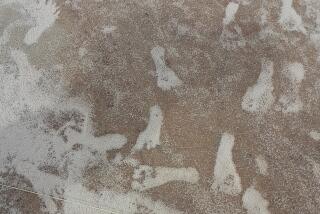Artifacts upend theory on first North Americans
A massive cache of 15,500-year-old artifacts from a Texas flood plain is providing what archaeologists are calling the first unequivocal evidence that the people of the well-known Clovis culture, long thought to be the first humans to inhabit North America, were not.
Archaeologists had previously found several sites, such as the Meadowcroft Rockshelter in Pennsylvania and the Paisley Caves in Oregon, that appeared to predate the Clovis culture and its distinctive fluted spear points, but the paucity of artifacts from those sites made such a conclusion highly controversial.
All of those sites together produced perhaps 800 artifacts total, but the new Buttermilk Creek site north of Austin has produced nearly 16,000 pieces — all of them buried beneath Clovis remains and thus older.
“It’s time to abandon the Clovis-first model and develop a new model for the peopling of the Americas,” said archaeologist Michael Waters of Texas A&M University, who reported his team’s new find in the journal Science. “This shows that people were in the Americas at least 2,500 years before Clovis, allowing plenty of time for the Clovis culture to develop here.”
Archaeologist Dan Sandweiss of the University of Maine, who was not involved in the research, added: “This really does bring the occupation of the New World into a pre-Clovis time.... Of the other sites, none are as fully convincing.”
The Clovis culture, so named because the first remnants were found nearly 80 years ago near Clovis, N.M., is characterized by its distinctive stone spear points, in which the Clovis people whittled out a groove that allowed them to affix a spear shaft. The people of this culture were thought to have crossed into the New World from Asia over the land bridge that once connected the two continents across what is now the Bering Strait.
The earliest Clovis-type remnants are about 13,000 years old. Similar implements have never been found in Asia, so anthropologists have not been certain of the origin of the people who used them.
The new discovery was made at a location formally known as the Debra L. Friedkin site, about 250 yards downstream on Buttermilk Creek from the better-known Gault site, which has been a rich source of Clovis-period artifacts. Both sit in a flood plain where spring floods frequently deposit sediment that has preserved the artifacts.
Buttermilk Creek is a spring-fed creek, so there is water year-round. There are abundant supplies of stone in nearby hills for making tools, and wildlife would have been abundant in the prairies to the north and the hill country to the west. It’s a place that hunter-gatherers “came back to continually for 15,000 years,” Waters said, and the team has found evidence of those many visits.
Under the layer of Clovis materials at the site, the team found a layer of sediment about 10 inches thick and dating from about 13,200 years ago to as far back as 17,000 years ago. From a relatively small area of the site, they removed 56 implements that were clearly tools, as well as more than 15,000 flakes, chipped stones and other artifacts that were clearly tool-related.
The tools included 14 spearheads that looked similar to the Clovis points, but lacked the grooves. That suggests that the people who migrated to the New World brought the spearhead-making technology with them, then developed the Clovis technology sometime after they arrived, said archaeologist James Adovasio of Mercyhurst College in Pennsylvania, who was not involved in the research.
The team also found blades and bladelets used for scraping, cutting and other purposes. A prize find was a chunk of hematite about the size of a golf ball with flattened sides from being rubbed on objects, and probably humans, to provide red coloring.
There was no organic material in the sediment layers, so the team could not use radiocarbon dating. But researchers at the University of Illinois used a relatively new technique called optically stimulated luminescence to date the soil surrounding the artifacts.
“Their science is really impeccable, and that is important when we are trying to document these early sites,” said archaeologist David G. Anderson of the University of Tennessee, who was not involved in the research. “They have multiple lines of evidence that support their interpretation.”
Previously, the best evidence for pre-Clovis occupation of the New World came from a site known as Monte Verde in southern Chile, which dates to about 14,500 years ago. But experts had questioned how the residents could have gotten that far south so early.
But the discoveries at Buttermilk Creek solve that riddle. “This shows that people were over almost the entire [North American] continent by 15,000 years ago,” Waters said. “That’s ample time for people to get to the southern tip of South America.”






